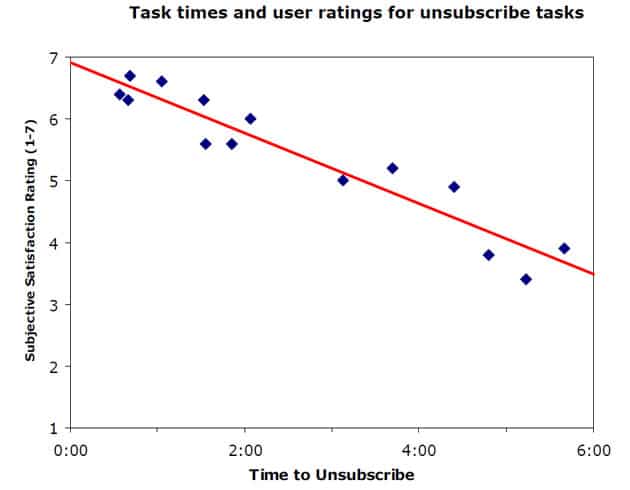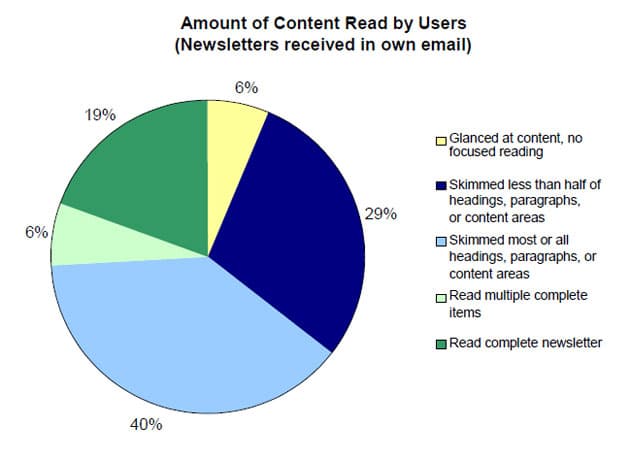Ergonomic best practices for newsletters – 1 of 2
Amy Schade and Jakob Nielsen, of the Nielsen Norman Group , recently published the third edition of E-mail Newsletter Usability , Third Edition . Since 2002, this study has analyzed how newsletters are perceived and used by readers. This year, the study covers 228 newsletters, and identified 165 rules for designing, sending and managing newsletters . Among the conclusions: keep it simple, make the content scannable, do not hide the link to unsubscribe, remain transparent, offer quality content… Here is what to remember from this study (a second article will follow soon, with an overview of good practices to apply).
Our file on good ergonomic practices for newsletters will contain 2 parts:
- 4 Takeaways from the E-mail Newsletter Usability Study (1 of 2)
- 12 best practices
1 – THE NEWSLETTER: A CONTRACT OF TRUST BETWEEN READER AND COMPANY
One of the first points highlighted by the E-mail Newsletter Usability study is the importance of newsletters in the relationship between the reader and the company. In fact, unlike the company's website, which is perceived as more remote, users receive the newsletter directly in their email inbox. This message thus touches a more personal sphere, and the reader reacts much more emotionally to a newsletter than to a website . This point of contact requires particular attention: the user perceives the problems of a newsletter as more serious, because they are closer, than the problems of a website.
2 – SUBSCRIPTION AND UNSUBSCRIPTION
“The slower the subscribe or unsubscibe process, the less people will like the site. (E-mail Newsletter Usability, Third Edition, Nielsen Norman group)
The E-mail Newsletter Usability study focuses in particular on the processes of subscribing to and unsubscribing from a newsletter. These processes are considered effective overall, since 81% of users succeeded in subscribing and 91% in unsubscribing. However, Nielsen Norman Group emphasizes the correlation between the time required to complete these tasks (an average of 4 minutes to register and 1.5 minutes to unregister) and user satisfaction: the more the registration and unsubscription are long, the lower the satisfaction .

Illustration of the correlation between satisfaction and time required to unsubscribe from the newsletter: the longer the time required, the lower the satisfaction. (Source and ©: Email Newsletter Usability, Third Edition, Nielsen Norman Group)
Paradoxically, it is therefore strategic to make unsubscribing easy and quick (in particular so that the newsletter is not classified as spam ). In addition, registration should not require too much effort on the part of the reader, at the risk of discouraging him: a field for the email address is sufficient , accompanied by an explanation of the frequency and content of the newsletter, as well as an overview of the latest newsletter.
3 – AVOID SPAM FOLDER
The use of newsletters is widespread today: 69% of users look forward to at least one newsletter, and most of them have integrated reading newsletters as part of their daily routine. As far as Canada is concerned, 80% of Internet users subscribe to at least 1 newsletter .
Keeping that spot in the inbox, and standing out against a slew of attention-hungry competitors, is no easy task. On average, users receive 58 emails per day on their work address, and they spend only 20 seconds deciding which newsletter they will read, based on the sender's name and the subject: in order not to be among the 18 % spam, newsletters must prove their interest for the reader, on a daily basis .

Information read by users for all newsletters received: few (19%) are read in full, most (20%) are browsed, at least in the main titles. (Source and ©: Email Newsletter Usability, Third Edition, Nielsen Norman Group)
4 – WHY THEY LOVE, WHY THEY LEAVE: WHAT THEY EXPECT
Users use newsletters primarily because they:
- keep them informed, remind/learn them of things they would have forgotten or would not have learned otherwise,
- in the case of professional newsletters, help them do their job, inform them about their profession or their company,
- require little effort on their part,
- avoid the waste of paper (represented for example by letters),
- can be transferred,
- are free, quickly delivered.
The main reasons for unsubscribing:
- the person is no longer interested in the content,
- the newsletter is unsolicited or very (too) frequent ,
- the content turns out to be different from what the reader expected,
- the information is considered useless ,
- the newsletter contains broken links or leads to a site with pop-ups ,
- too much publicity, too many images.
However, unsubscribing is an end to which users are reluctant to resort: they prefer to declare the sender as spam , or simply not to read the newsletter, so as not to break the relationship with the company and because they fear consequences of this procedure (validation of the email address and therefore receipt of more unsolicited emails, etc.)
What readers expect from newsletters (excerpt):
- quality ( writing , design),
- interesting and topical information,
- quickly scannable content (subject and sender of the email, titles, bullet points), brief and concentrated content,
- be able to transfer and print the information,
- be able to subscribe and unsubscribe quickly (stay in control).
In conclusion, the newsletter is a privileged means of communication for the company, since it makes it possible to reach the reader in his personal environment. Readers are therefore very demanding of this form of communication. Content and form are judged on a daily basis, and a newsletter that loses its quality or interest risks (worse than unsubscribing) being declared as spam, with significant consequences on the perception that the drive has company.











